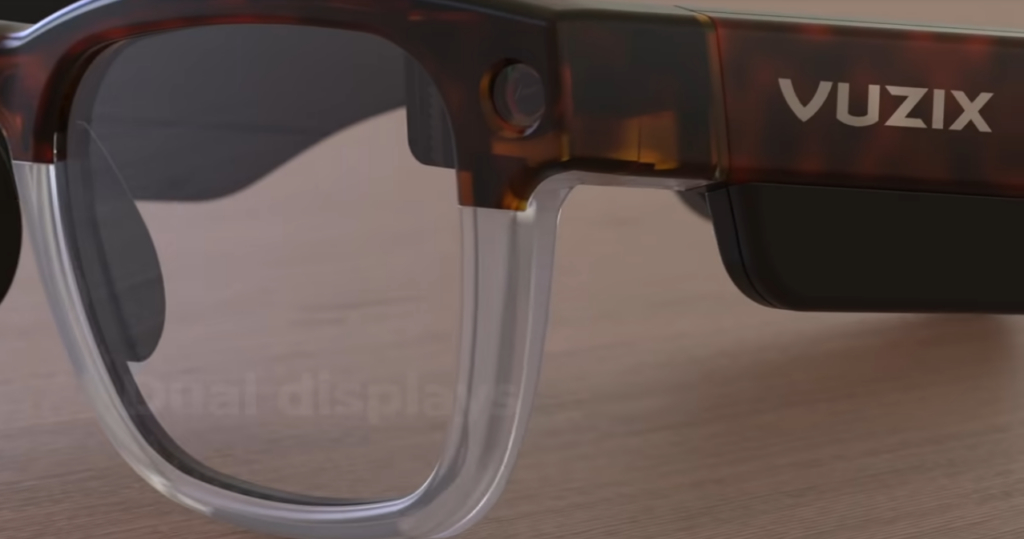
What happens when you put two superior optical technologies together? In the case of smart glasses you get bigger, brighter and less blurry.
Kingsman-style smart glasses have been available for more than a year now but they typically have flat glass lenses which are difficult to adjust for the 50% of the adult population who wear prescription glasses. A new joint venture between microLED device manufacturer Jade Bird Display (JBD) and smart glasses developer tooz technologies GmbH (tooz) is set to change that. On January 20th 2022 the companies announced a collaboration to put bright microLED displays into glasses with curved lenses. A first demonstration is taking place at the Photonics West SPIE AR VR MR 2022 exhibition (23rd – 25th January 2022 in San Francisco, USA).
Almost exactly one year ago Corbeau reported an Insight on new micro-LED driven smart glasses from Vuzix, a major breakthrough in terms of connectivity and what we now call the Metaverse. With existing products for industrial and medical applications, Vuzix announced the NGSG (Next Generation Smart Glasses) for the consumer market. NGSG combined tiny high resolution microLED red/green/blue displays with their state-of-the-art waveguide optics for displaying 3D images in front of the wearer’s eyes.

In the past year a number of new players have entered the market with their own smart glasses. Xiaomi, a budget smartphone manufacturer from China, has glasses with a monochrome green display based on what looks like a Jade Bird Display 0.1″ device. Lenovo has launched the ThinkReality A3 with high resolution AR display but a rather heavy look. TCL’s Nxtwear G glasses offer high resolution cinema-style projection and get around the prescription lenses issue with a custom frame that looks a bit like Neo and Trinity’s eyeware from the Matrix. But on stalks.
tooz (it seems strange to start a sentence without a capital letter) make much of their new curved waveguide technology. Vuzix developed a waveguide element to their smart glasses which enabled light of different wavelengths to be projected as a image in three dimensions in front of the wearer’s eyes. This was amazingly cool. tooz have gone one better and invented a curved waveguide, which realises a number of improvements to the design and performance of smart glasses. Reading through technical presentations from tooz, Corbeau spotted seven major advantages of curved waveguides compared to planar waveguides:
- unbreakable plastic rather than brittle glass
- lighter and more compact than glass
- use less optical elements due to curved surfaces bending light
- require just one waveguide layer rather than one for each colour
- material rejects sunlight and rain interference outdoors
- curved waveguide reduces display visibility to others
- curved waveguide claimed to be more efficient than planar ones

Where do Jade Bird Display fit into the picture? tooz started developing their smart glasses with OLED light sources rather than microLED. OLEDs typically have some advantages but their big disadvantage is the displays are not as bright as microLED displays. Waveguides have amazing properties but are lossy, they waste much of the light intensity passing through them. The tiny microLED displays from JBD have brightness values of millions of nits (the iPad has a humble several thousand nits). This means they can be used outdoors in full sun, to project usable images over wide angles even though much of the light is lost in the waveguide. JBD also have a rather neat X-cube optic which combines the outputs from tiny individual red, green and blue microLED displays no bigger than a grain of rice.

So where does this great technical synergy lead? With the possibility of smart glasses for the whole population, including the 50% who require prescription lenses, a massive potential market is opened up. tooz aren’t just targeting technophiles, they have real-life commercial applications in their sights. Vuzix have a business model that has targetted early adopters in the engineering services sector. tooz are pushing their new products into engineering and medicine. They have a fascinating promo video of a pilot study at the University Hospital of Dresden (see the bottom of this Insight for a link).

One more thing. tooz started out as a new venture between optics experts Carl Zeiss and IT giant Deutsche Telekom. They have automated manufacture for volume manufacture of optics and real reach into IoT in the field.
Smart glasses are now real products with commercial benefits. The party is just getting started and we haven’t seen what Apple and Facebook will bring to the party yet. Could the next two years see the death of the smart phone and the birth of the Matrix?
Visit the Photonics West SPIE AR | VR | MR 2022 .
Find more tooz company information .
Find more Jade Bird Display company information .
See the Xiaomi smart glasses video.
View the TCL Nxtwear G glasses.
See the tooz glasses University Hospital Dresden promo video